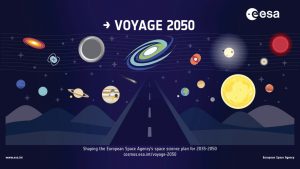The European Space Agency is shaping its science programme for the period 2035-2050
After the Horizon 2000 programme started in 1983, followed by its extension Horizon 2000 Plus, the European Space Agency (ESA) is committed until 2035 into the Cosmic Vision programme that includes the launches of Athena (2031) and LISA (2034). To plan its scientific priorities beyond this date, ESA has solicited the community through a call for ideas/projects. This consultation, presented at a conference in Madrid late October 2019, resulted into the publication of nearly 100 White Papers, covering fields as distinct as fundamental physics, exploration of the solar system or the study of the distant universe. The evaluation process will culminate in 2020 with a series of recommendations addressed to the ESA's scientific directorate. Scientists from the Astrophysics Department/AIM Labporatory and collaborators have answered positively to this call by proposing several projects, some of which described below.
The programme of the Madrid workshop, the various presentations and the access to all the White Papers submitted by the scientific community are available on the ESA website “Voyage 2050”.
It should be noted that ESA has also invited the general public to participate to this adventure and to share his views for this next ESA space programme.
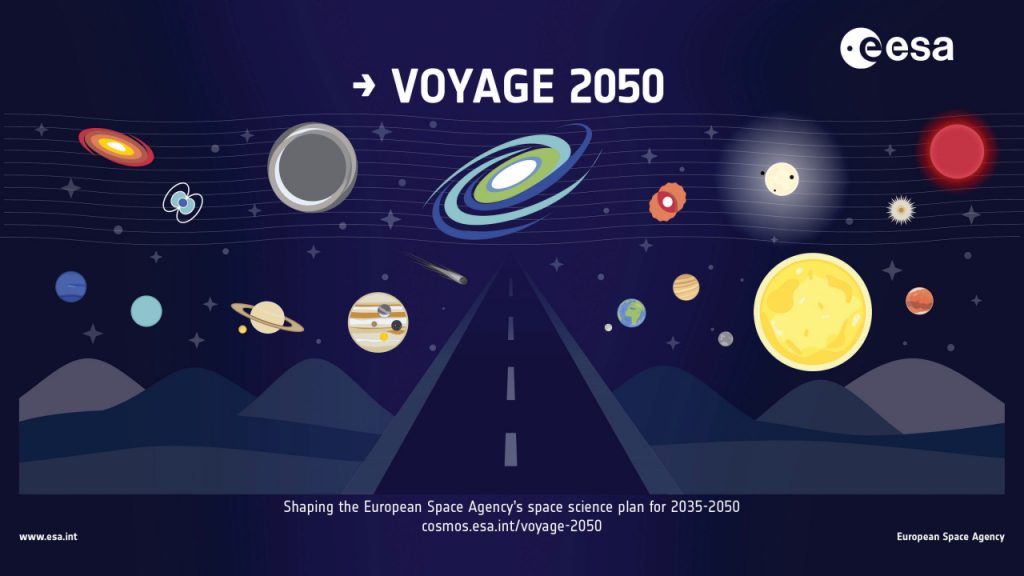
An appropriate timeframe
As outlined by Prof. Günther Hasinger, ESA Director of Science: “organizing this consultation at the end of 2019 is an appropriate time to define the scientific priorities of the agency for the period 2035-2050”. He recalled that the first workshop of the Cosmic Vision programme, whose aim was to shape the period 2015-2025, had been held in Paris in 2004 and see its first concrete achievement at the end of 2019 with the launch of the CHEOPS mission. The meeting held in Madrid at the end of October 2019 thus met its timely this objective: prepare the ESA's scientific programme for the period beyond 2035.
The scientific themes covered during the conference covers a large number of research fields, as attested by the diversity and originality of the presentations: in situ experiments in space, configurations of experiments requiring formation-flying missions, constellation of satellites to study solar plasma, samples Earth return of solar system bodies, asteroid interceptor, experiments to probe the distant Universe, bunch of identical telescopes deployed in space for interferometric measurements, etc. Presentations from other international space agencies, as NASA, JAXA, Roscosmos and CSA, were also shown during the meeting. The content of these presentations is accessible through the conference website.
Involvement of the Astrophysical Department
esearchers from the Astrophysics Department/AIM Laboratory and collaborators are at the origin of – or have amply contributed to – several white papers, touching on most of the scientific themes at the heart of the laboratory's activities. Below is a short description of the main projects (for each project, the link to its White Paper and the CEA point of contact are given).
A complete census of the gas phases in and around galaxies: far-UV spectropolarimetry as a prime tool for understanding galaxy evolution and star formation
Contact: Vianney Lebouteiller
The far-UV wavelength range (~912-2000A) provides access to atomic and molecular transitions of many species in the interstellar medium (ISM), circumgalactic medium, and intergalactic medium. Future UV spectroscopic studies of the Milky Way must revolutionize our understanding of the ISM as a dynamical, unstable, and magnetized medium, and rise to the challenge brought forward by current theories. Another interesting prospect is to transpose the same level of details that has been reached for the Milky Way to the ISM in external galaxies. Finally, it is urgent to comprehend the actual role of gas exchanges and flows for galaxy evolution. For such objectives, we advocate for a large UV telescope for ESA Voyage 2050, potentially as a joint ESA-NASA mission.

PHEMTO : Polarimetric High Energy Modular Telescope Observatory
Contact: Philippe Laurent
The energetic physical processes taking place in stars, around compact objects (neutron stars, black holes), at the origin of the hot gas present in galaxy clusters produce high energy radiation. Do so the acceleration mechanisms taking place in shocks in supernova remnants or those at the origin of the powerful ejections of matter observed in active galaxies. These phenomena have as signature photons with energies ranging from 1 keV (X-soft photons) to several hundred keV (notably those tracing the presence of antimatter with the 511 keV electron-positron annihilation line). Today, covering this full spectral range requires the use of several satellites.
The Polarimetric High Energy Modular Telescope Observatory (PHEMTO) proposes to overcome this difficulty by using two focusing systems, one for the low energy band, the other for the high enrgy side, but both equipped with an identical detection plane located on a common platform. The low-energy telescope (focal length 15-20 m), with improved ATHENA, NuSTAR or Hitomi type mirrors, will cover the 1-200 keV range, while the neighbouring high-energy telescope, based on the principle of Laue lenses (diffraction of light onto crystals) and with a focal length of 100 m (achievable in the coming decades thanks to a formation flying configuration) will give access to the 50-600 keV energy range. In both cases, the detection system is based on an array of silicon detectors placed above a CdTe detector array. Improvements in the mirror conception and on the detectors performances will be supported, thanks to Voyage 2050, by a sustained Research & Development programme. Last but not least, the technical configuration proposed makes PHEMTO a powerful and unique polarimetric observatory in a wide energy band, and a tool to achieve objectives in the core of the scientific case.
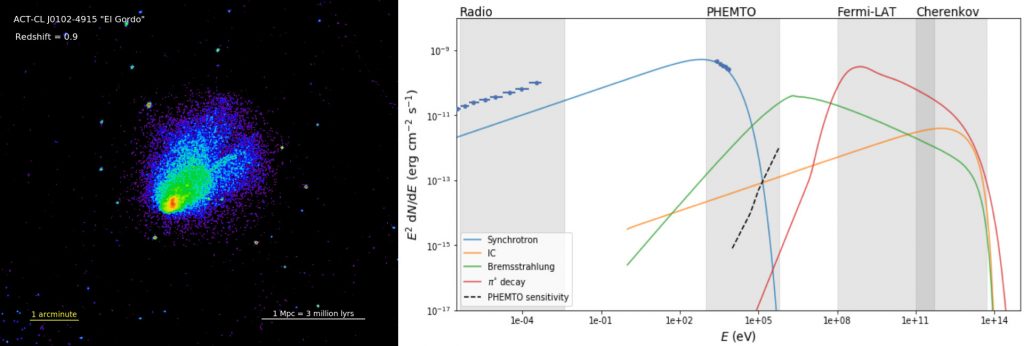
Voyage through the Hidden Physics of the Cosmic Web
Contact: Gabriel Pratt
Most of the baryonic content of the Universe is found into the hot, diffuse gas around galaxies, in groups and clusters of galaxies, and in the filamentary gas that links these structures together (the “Cosmic Web”). So far, the detection of this hot gas, which emits low-energy X-rays, is limited to regions where the gas is densest, such as in groups and clusters of galaxies. The excellent X-ray detection efficiency in the 0.1-10 keV range of the proposed project and its unique spectral resolving power make this observatory a Cosmic Web Explorer. It will allow the detection and characterization of the physical properties, for the first time, of gas in the less dense areas, undetectable today, present in the environment of individual galaxies and in cosmic filaments.
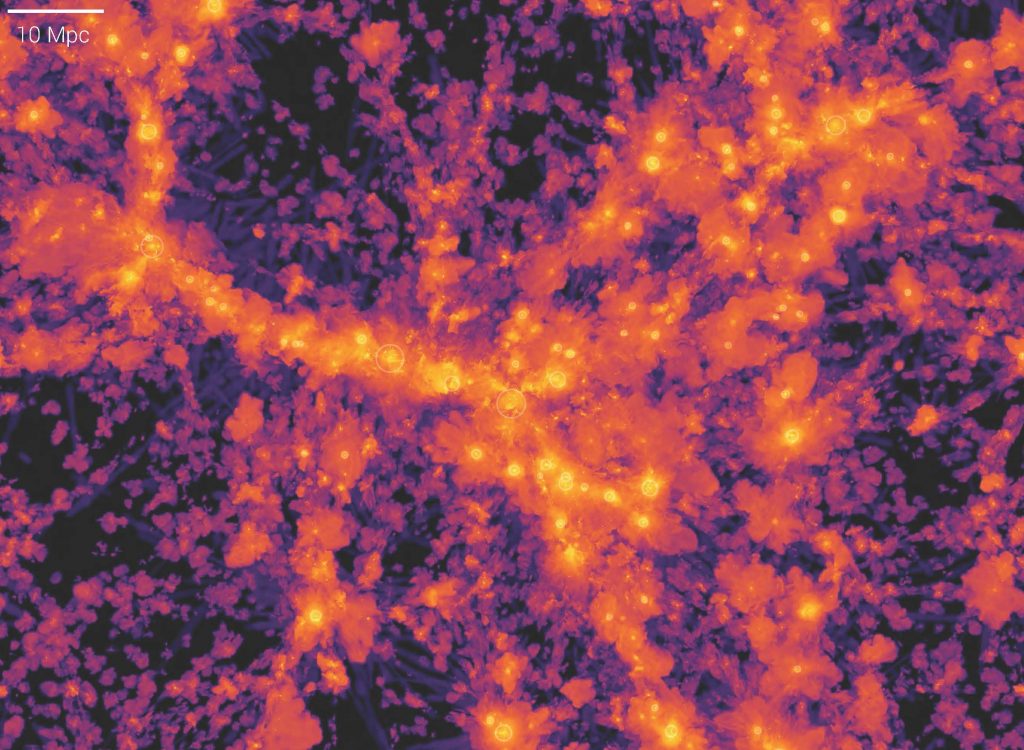
Bringing high spatial resolution to the Far-infrared – A giant leap for astrophysics
Contact: Marc Sauvage
Far Infrared covers the range 30-300 μm (10-1 THz), a region where the atmosphere is particularly opaque, requiring observations from space. But till today observatories (as ISO, Spitzer, Herschel) have offered a moderate spatial resolution, at best one arc second, which limits access to key information. One of the topics that is currently difficult to access for observations and a major theme of the proposed project is the study of the role of water in proto-planetary disks. High spatial resolution in the far-infrared is the only energy range allowing mapping the disks in the H2O bands, paving the way for the possible detectability of habitable planets and the emergence of life. Coupled with high spectral resolution, remote IR observation also provides access clue informations on the physics and chemistry of the processes leading to star formation in our galaxy. The high FIR spatial resolution of this project (sub-arcsecond) requires the implementation of interferometric solutions through the combination of signals from several telescopes typically separated by 1 km or through the original use of a single large mirror (20m outside diameter) deployed in space as proposed in the TALC mission concept .
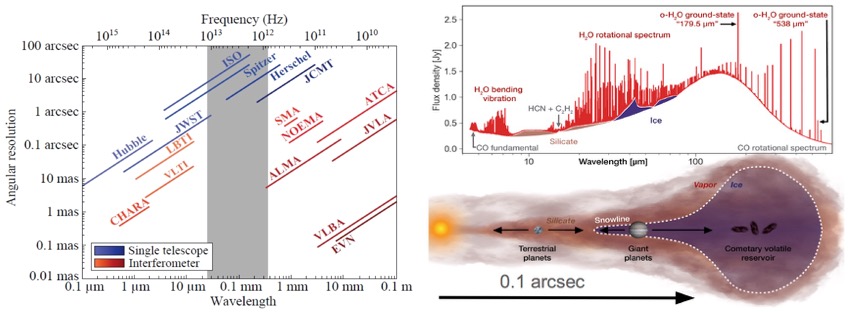
Microwave Spectro-Polarimetry of Matter and Radiation across Space and Time
Contact : Jacques delabrouille (DAp et APC)
This paper discusses the science case for a sensitive spectro-polarimetric survey of the microwave sky. Such a survey will provide a tomographic and dynamic census of the three-dimensional distribution of hot gas, velocity flows, early metals, dust, and mass distribution in the entire Hubble volume, exploit CMB temperature and polarisation anisotropies down to fundamental limits, and track energy injection and absorption into the radiation background across cosmic times by measuring spectral distortions of the CMB blackbody emission. In addition to its exceptional capability for cosmology and fundamental physics, such a survey will provide an unprecedented view of microwave emissions at sub-arcminute to few-arcminute angular resolution in hundreds of frequency channels, a data set of immense legacy value for many branches of astrophysics. We propose that this survey be carried-out with a large space mission featuring a broad-band polarised imager and a moderate resolution spectro-imager at the focus of a 3.5m aperture telescope actively cooled to about 8K, complemented with absolutely-calibrated Fourier Transform Spectrometer modules observing at degree-scale angular resolution in the 10-2000 GHz frequency range. We propose two observing modes: a survey mode to map the entire sky as well as a few selected wide fields, and an observatory mode for deeper observations of regions of specific interest.

Next steps
As part of the on-going evaluation process, the projects were grouped under 5 themes: Sun/Plasma, Solar System, Stars / Evolution of Galaxies, Extreme Universe, Cosmology/Astroparticle / Fundamental Physics. All the White papers are currently being examined by a panel of fifty experts (called Topical teams) selected by ESA. The conclusions of their works will then be addressed to the Senior Committee in spring 2020. This committee will then transmit its recommendations to the ESA's scientific directorate.
More infos :
- Web site Voyage 2050 of ESA
- The programme of the workshop Voyage 2050, Madrid, 29-31 Octobre 2019 (acces to the presenations in pdf format)
- White papers (pdf documents)


